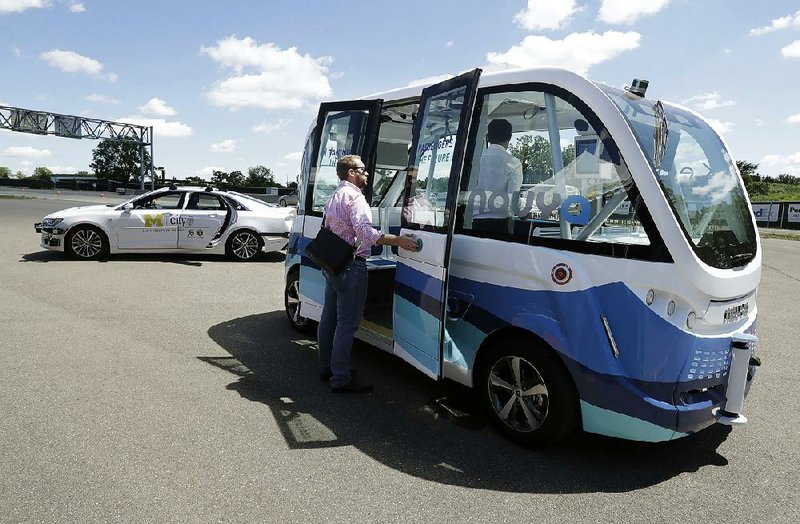It didn't take long for Pritam Singh to learn a key lesson about working for Lyft. People are disgusting. They have a nasty habit of throwing up in moving vehicles.
Ride-hail drivers are acutely aware that customers tend to do that, along with slightly less annoying things like wiping hamburger-greasy fingers on armrests and turning floor mats into swamps of slush. Singh, who ferries passengers for Lyft Inc. in Manhattan several evenings a week, spends about $200 a month on cleaning his Toyota Camry.
For General Motors Co., Uber Technologies Inc. and others thinking about robo-taxis, the bill could be in the tens of millions of dollars annually. When insurance, inventory storage and the steadily shrinking value of beat-up cars are added in, the cost could be billions.
That casts a pall on the idea, held dear by the likes of Uber co-founder Travis Kalanick, that the advent of self-driving will swiftly make ride-hailing so cheap that most Americans won't bother to own their own vehicles.
How to deal with messes represents one of many great unanswered questions about the business model that Kalanick once summed up as getting rid of "the other dude in the car." In the future he and Lyft co-founder John Zimmer have described, apps and bots do the work, consumers save big time and investors just rake it in. But number-crunchers at GM and companies including Apple Inc. and Alphabet Inc.'s Waymo are adding up a lot of costs that will get in the way of robo-taxis being cash cows.
Apple and Waymo have turned to Avis Budget Group Inc. and Hertz Global Holdings Inc. for help in managing driverless fleets. Even big rental companies, though, have struggled to contain their own costs in taking care of cars and trucks used by the great unwashed public.
"It is a really big issue and no one has figured it out," said Mark Wakefield, co-head of the global automotive practice at the consulting firm AlixPartners. "No one is even betting on the outcome."
That's not to say the no-driver prize won't eventually be worth a lot, which is why so many are jockeying for position and doing their homework.
GM's Maven unit, which competes with Avis' Zipcar in the hourly rental business and leases vehicles to Uber and Lyft drivers, has studied how much abuse ride-share vehicles take. In addition to the damage inflicted and filth deposited by customers, the costs for insurance and parking -- pricey in New York and San Francisco, where ride hailing is popular -- will be substantial, said Peter Kosak, GM's executive director of urban mobility.
Ready or not, robo-taxis are being prepared for the roads. GM Chief Executive Officer Mary Barra said last month that the automaker is expanding its fleet of self-driving, all-electric Chevrolet Bolts from 50 to 180. Lyft plans to test the Bolt as a robo-taxi in San Francisco, with a human baby-sitting the steering wheel. GM also will run trials in Detroit and Scottsdale, Ariz.
The robo-taxi, without any human to compensate for navigating traffic, might indeed be a gold mine. Its arrival could be one of those big economy-altering events, freeing up acres of parking space in cities, eliminating the need for garages in homes and handing people thousands of dollars a year in new disposable income. AlixPartners' Wakefield said it could fundamentally change how many people view and buy transportation.
Lyft's Zimmer recently described a personal vehicle as "a ball and chain that gets dragged through our daily life" and predicted that by 2025, private car ownership will "all but end" in major U.S. cities.
That will happen only if companies like GM can figure out how to make all the costs makes sense. "Lyft and Uber don't care about managing the fleet," said GM's Kosak. "Down the road, you'll need to dictate who does all of that."
It probably won't be Lyft, according to Brian Hsu, the company's vice president of supply. "We stay asset light," Hsu said. "We realized very early on that fleet management is like real estate management. That's a capability that is very different from what we do."
Hsu said rental-car companies could be an answer because they have expertise, along with vast lots in cities all over the U.S. Hertz has a deal to manage a small fleet of self-driving Lexus RX 450h sport utility vehicles for Apple, and Avis has inked a similar arrangement with 600 self-driving Chrysler minivans for Alphabet Inc.'s Waymo autonomous technology division.
What might the rental companies charge? They typically deal with depreciation of more than $300 per car every month; Hertz has $10 billion in vehicles on its books and depreciates them to the tune of $2 billion a year. Add in cleaning and maintenance, and the total may be $400 to $600 per vehicle a month, Wakefield said.
SundayMonday Business on 07/17/2017

